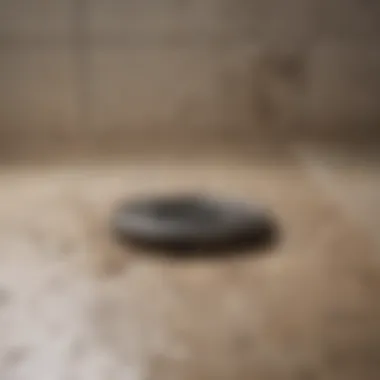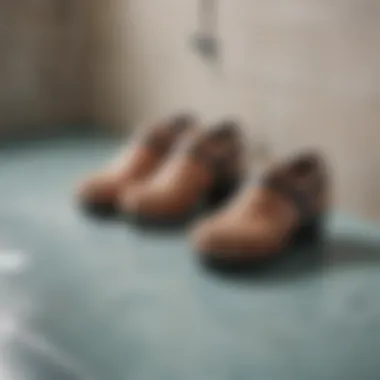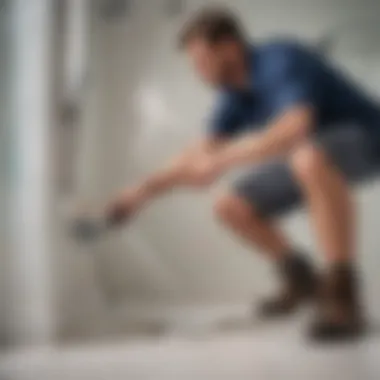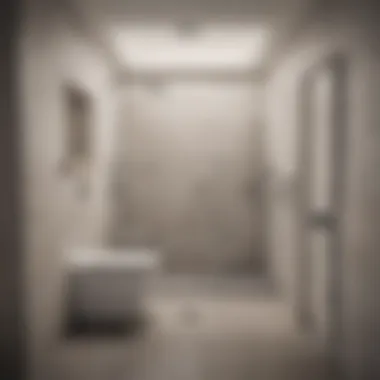Understanding Shower Clogs: Causes and Solutions


Intro
Shower clogs are a prevalent yet often overlooked issue that can disrupt daily routines and pose potential hazards in residential plumbing systems. The nature of these clogs often links back to various contaminants which, when left unattended, can lead to significant consequences and costly repairs. Understanding their causes and effects is crucial for maintaining effective drainage systems.
Common blocks result from the accumulation of hair, soap, and other debris. Moreover, the design of certain showers can exacerbate these issues. This article aims to provide clarity on a topic that is as fundamental as it is crucial for anyone responsible for the upkeep of their home.
In this discourse, we will cover the primary causes of clogs, discuss the implications of ignoring plumbing issues, and explore practical solutions to prevent and address these common challenges.
Causes of Shower Clogs
Hair Accumulation
The most frequent culprit for shower clogs is undoubtedly hair. It tends to accumulate around drains and can entangle with other material. Regular maintenance and the use of drain covers can significantly reduce the amount of hair entering the plumbing.
Soap and Product Residue
Another contributing factor to clogs is soap residue and hair products. Over time, these residues can collect and harden, forming a solid mass that obstructs flow. Individuals should opt for biodegradable products where possible to lessen this impact.
Impact of the Drain Structure
Various drain designs can influence clogging. For example, shallow drains may encourage build-up compared to deeper systems. Understanding your specific shower’s drainage structure can help in assessing potential risks.
Consequences of Untreated Clogs
Water Damage
One major downside of ignoring clogs is water damage. Standing water can saturate surrounding materials, damaging tiles and promoting mold growth. These problems escalate repair costs significantly.
Hygienic Concerns
Untreated clogs can become breeding grounds for mold and bacteria, which pose health risks to inhabitants. Ensuring that drains function properly helps create a healthier living environment.
Solutions for Prevention and Remediation
Regular Cleaning
Implementing a routine cleaning schedule can mitigate many clog-related issues before they become costly repairs. Monthly deep-cleanings focus on both the drain and the surrounding areas.
Use of Drain Covers
A drain cover can be an effective barrier against hair and larger debris. Educating household members on its importance aids in promoting consistent use.
Professional Inspections
For persistent issues, engaging a plumbing professional may provide insights or solutions beyond regular maintenance. Comprehensive inspections can catch underlying problems before they escalate.
Pro tip: Keep a jar of baking soda and vinegar ready at home. This natural solution can unclog drains if used regularly.
Closure
Being proactive about understanding the causes, consequences, and solutions to shower clogs can save time, money, and hassle. Maintaining optimal drainage supports not just functionality but enhances the long-term health of plumbing systems.
Understanding these aspects ensures you can effectively manage this often-neglected component of home maintenance.
Intro to Shower Clogs
Understanding shower clogs is important for any homeowner. A blockage can cause both inconvenience and potential danger to your property. Knowing why your shower may get clogged and how to address those issues is vital. The topic also involves understanding the broader implications of plumbing problems, as they can affect various aspects of home maintenance.
Definition and Importance
A shower clog occurs when there is a blockage in the drainage system, preventing water from flowing properly. This issue might arise slowly over time or happen suddenly, depending on the cause. The persistence of a clog can lead to undesirable consequences, such as unpleasant odors or water backup.
The importance of recognizing clogs early cannot be overstated. Regular attention can avert significant plumbing investments and improve hygiene in your home. Thus, whether it’s routine maintenance or remedial measures, knowledge of shower clogs is essential.
Overview of Common Issues
Shower clogs can manifest in various ways. They typically arise from several primary causes, each requiring unique attention.


- Hair accumulation: As your shower sees daily use, hair follicles can build up, leading to blockages.
- Soap scum: Regular soap use develops residues that cling to pipes, creating obstacles to water drainage.
- Foreign objects: Items such as shampoo caps or small toys may accidentally fall into the drain, obstructing proper water flow.
- Pipe damage or corrosion: Old pipes may corrode or sustain damage, making them more susceptible to clogs.
Each of these issues represents a significant concern within residential plumbing. Timely identification and resolution of these problems can greatly enhance your shower experience and improve the overall condition of your plumbing system.
Causes of Shower Clogs
Understanding the causes of shower clogs is critical for maintaining a functional and efficient bathroom. Identifying these issues can prevent larger plumbing problems down the road. Each causes described below has specific implications, and knowing them enables homeowners to adopt proper preventive measures.
Hair Accumulation
Hair is often a primary suspect when it comes to shower clogs. It tends to collect in drains, where it gets tangled with soap residues and skin oils. This can lead to a drastic reduction in water flow, which is usually noticed when the shower starts to take longer to drain.
Often, losing a few strands of hair in the shower may not seem significant. However, over time, the accumulation can become a concerning obstruction. Additionally, longer hair types, such as those owning to women, are more prone to causing problematic clogs due to their length and texture. The most effective way to combat this issue is to utilize drain screens or hair catchers. These tools can significantly reduce the amount of loose hair that ends up in the drain, thereby preserving drainage efficiency.
Soap Scum Build-up
The build-up of soap scum is another contributing factor to clogged showers. Soap scum consists of a mixture of soap residue, body oils, and minerals found in water, particularly hard water which has a certain level of dissolved minerals like calcium and magnesium. When soap interacts with these minerals, it creates a thick, sticky residue that can easily adhere to the sides of the pipe and fixtures, leading to partial or complete clogs.
Regular cleaning of the shower and allowing time for vinegar or commercial solutions to work can help mitigate the problem. By addressing soap scum promptly, not only the aesthetics of a shower improves, but its functionality gets maintained as well.
Foreign Objects
Foreign objects in the shower can create serious clogging issues. Items like shampoo caps, small toiletries, and even toys can accidentally slip down the drain. These objects often don't decompose or break down easily, compounded by the existing build-ups of hair and soap scum, resulting in more pronounced blockages.
To reduce the frequency of such clogs, it is prudent to be mindful of where stray items are left in the shower area. Implementing check-up procedures to visually inspect the drain area can alert residents to potential incursion paths for foreign objects.
Pipe Damage or Corrosion
Damage and corrosion of piping can lead to clogs that are more severe and require significant attention. Over time, chemical reactions and age can weaken pipe material, leading to cracks or corrosion. These issues not only can cause blockages but also grow into leaks that can damage home infrastructure.
If any signs of dampness or greenish streaks appear around exposed plumbing, a professional should be consulted. Repair or replacement may become necessary for long-term plumbing reliability. Catching these challenges early on saves homeowners future costs associated with water damage or prolonged plumbing problems.
Consequences of Clogged Showers
The consequences of clogged showers extend beyond mere inconvenience, striking at the core of home functionality and hygiene. Understanding these impacts helps homeowners appreciate the importance of maintaining clear shower drains. Addressing clogs not only improves the immediacy of shower use, but it also mitigates potential long-term damage and unwanted expenses.
Reduced Water Flow
One of the most immediate effects of a clogged shower is the reduced water flow. As hair, soap, and other debris obstruct the drain, water cannot pass through effectively. This often results in sluggish drainage, leading to standing water in the shower. As more water accumulates, the basic functionality of the shower diminishes. Users may feel dissatisfied with their shower experience as the water pressure decreases, making it difficult to rinse off properly. This decline in water flow can quickly become an aggravation.
Potential Water Damage
Clogs can lead to significant water damage over time. When water cannot drain appropriately, it creates puddles that promote mold and mildew growth. This not only impacts the aesthetics but also the health environment of the bathroom. Moreover, if the water seeps into the walls or flooring, it can compromise structural integrity. Repairing water damage can be considerably expensive and time-consuming. Thus, understanding the potential for water damage emphasizes the need to resolve any clog issues promptly.
Increased Maintenance Costs
As clogs persist, a homeowner may find themselves facing increased maintenance costs. Ignoring minor clogs allows them to become serious plumbing issues, which often require professional intervention. Plumbers like Roto-Rooter can provide required solutions, but these services come at a cost that can easily spiral out of control. The accumulation of fees for recurring repairs can negate any slight savings from delaying action. Regular maintenance is a far more cost-effective solution than reactive emergency repairs.
Health Implications
Health risks arise from clogged showers due to standing water. This stagnant water presents a breeding ground for bacteria and other pathogens. Mold spores, in particular, are a notable concern. They can trigger allergic reactions and respiratory problems. Ensuring a clean, clear shower is vital not just for comfort but equally for maintaining health standards. To minimize the risk of such issues, being proactive about drainage is essential.
Proactive drain maintenance today can prevent serious problems tomorrow.
The consequences of clogged showers serve as a reminder of the importance of conscientious maintenance. Homeowners should act on early signs of clogs to safeguard their bathrooms from damage and uphold hygiene standards.
Initial Assessment of Clogs
When faced with a shower that is draining poorly, an initial assessment is crucial. Understanding the state and severity of a clog can help save time, money, and stress in the long run. Proper assessment identifies whether a simple fix is possible or if professional intervention is required.
Clogs can lead to more significant problems if left unattended. Knowing how to accurately assess a shower clog can help establish the confidence to tackle plumbing issues. Furthermore, diagnosing the specific cause of the blockage allows for targeted solutions, improving the effectiveness of remediation efforts.
Identifying the Severity
Determining the severity of a clog is essential in deciding on the correct course of action. A few indicators help in assessing the condition:
- Minor Slow Drainage: If water drains slowly but eventually does so, it may be a sign of a partial blockage. Regular cleaning methods may resolve this.
- Complete Drainage Failure: If water stands still in the shower, a significant blockage has occurred. Here, taking immediate action is advisable.
- Foul Odors or Visible Accumulation: Look for unpleasant smells or visible debris. Strong odors can indicate more profound problems related to damage in pipes, requiring further inspection.
In summation, clearly identifying the severity of the clog limits any unnecessary expenses in maintaining plumbing. Create a plan that matches the condition found in your assessment.


Checking Drainage Rates
The next step in the initial assessment is checking drainage rates. This refers to how quickly or efficiently water flows through the shower drain. Conduct this simple test:
- Fill the shower basin with a few inches of water.
- Observe how fast the water drains once released.
- Suppose water takes notably longer than two minutes to drain completely; this is a strong indication of a clog.
Understanding these measurements answers questions about a clog's urgency and whether immediate action is necessary. High drainage rates indicate the pipes might be clear, while low rates reflect the need for proactive measures.
By familiarizing yourself with assessing clogs effectively, you can more efficiently manage your plumbing issues at home, minimizing future inconveniences.
Tools for Unclogging Showers
Unclogging showers effectively requires the right tools. Utilizing proper tools aids in efficient drainage remediation, saving both time and effort. Being equipped with the necessary instruments can significantly lightens one’s workload and potentially rescues a fragile plumbing situation. Careful selection of unclogging tools is also pertinent to avoid further damage to pipes or permanent blockages.
Plumber’s Snake
A plumber’s snake, often referred to as a drain auger, is a flexible tool designed to navigate through pipes. It has a coiled end capable of breaking down or removing hair, soap scum, and other debris that typically causes clogs.
Key Benefits:
- Deep Reach: It can reach lengths up to 25 feet or more, making it helpful for distant clogs.
- Versatility: Ideal for various drainage systems, not just showers.
- Efective Cleaning: Actively breaks apart tough blockages.
Consider using a plumber’s snake with care. Misuse may lead to damage, so understanding its operation is important.
Plunger
The plunger is a classic tool known for its simplicity and effectiveness. It creates suction and pressure, which in turn can dislodge clogged materials.
Benefits and Considerations:
- Accessibility: Plungers are easy to obtain and inexpensive.
- Quick Solution: Often provides immediate results for minor clogs.
- Technique Matters: Timing and technique play crucial roles, as high-pressure can sometimes force issues deeper into plumbing. Make sure you have a firm handle and position effectively.
Drain Cleaning Solutions
Chemical or enzyme-based drain cleaning substances can also be employed. They are designed to dissolve materials without mechanical effort.
Factors to assess include:
- Material Composition: Choose products that are safe for your specific pipe type, as harsh chemicals can exacerbate corrosion.
- Eco-Friendliness: There are environmentally safe options that apply less risk to your health and plumbing systems.
- Fume Caution: Use in a well-ventilated area since some products contain strong odors.
DIY Methods for Clearing Clogs
Dealing with shower clogs can be a frustrating experience. Knowing some DIY methods to address these issues can save time and potentially costly plumbing fees. Understanding these techniques is essential for ensuring that your home's drainage systems operate efficiently. Not only can they provide immediate relief from blockages, but they also promote an understanding of how various materials and substances can combine within pipes to create clogs. This section delves into practical approaches homeowners can take to alleviate shower backups.
Boiling Water Technique
One effective and simple method to clear minor shower clogs involves using boiling water. The high temperature can dissolve soap scum and grease that accumulate over time in pipes. Here’s how to execute this method:
- Start by boiling several kettles of water. One gaallon is usually sufficient.
- With care, pour it slowly down the drain in two to three phases. This warm liquid could prevent further buildup.
- Allow some time for the hot ait to act, and follow up by flushing the drain with cold water.
This method is notably resourceful but keep in mind that it may not address more serious clogs, such as those caused by hair or physical blockages.
Baking Soda and Vinegar Approach
Another popular DIY solution employs the combination of baking soda and vinegar. This technique leverages a chemical reaction that helps to unclog pipes without harsh chemicals. The process goes as follows:
- First, pour one cup of baking soda directly into the drain.
- Next, slowly add one cup of vinegar. Allow the mixture to fizz and react for about 15 minutes.
- Finally, rinse with boiled water to help clear any loosened material.
This approach stands out as it not only clears some types of clogs but also acts as a deodorizer for drains. It’s a safe option compared to sometimes corrosive chemical drain cleaners.
Manual Removal
In situations where a clog persists despite attempting other methods, manual removal could become necessary. This method allows for directly addressing the blockage.
- First, gather necessary tools such as gloves, a drain snake, or just your hands if you can see/ reach the blockage.
- Clear the drain cover and check if there is visible hair or debris.
- Using a claw tool or enhancing your dexterity can assist in reaching into the drain to pull out obstructive material.
Keep in mind that wearing gloves is essential, and ensure that you take care of what you pull out. If the clog persists, it could hint at issues deeper within the plumbing that shadow any remedies done manually.
Engaging in DIY methods for clearing clogs can foster an understanding of home plumbing systems and enable more informed maintenance approaches in the future.


When to Seek Professional Help
Understanding when to call a professional plumber is a critical aspect of maintaining healthy shower drainage. Many homeowners may attempt to manage minor issues but fail to recognize the signs of more severe problems lurking beneath the surface. Waiting too long can lead to costly repairs or health hazards. Thus, knowing precisely when to escalate the matter is vital for both preserving one's investment and ensuring safety.
Persistent Clogs
One of the clear indicators that professional intervention is necessary is the occurrence of persistent clogs. If the same blockages reappear despite DIY strategies, it suggests underlying issues. Some common causes for reoccurring issues include:
- Fatty and oily residues incapable of being sufficiently dissolved by household cleanings.
- Nearby plumbing issues that may exacerbate the clog.
Ignoring these repetitions can cause more substantial damage over time. Therefore, if one finds oneself reaching for a plunger or snake frequently, it may not be a mere coincidence.
Signs of Pipe Damage
Another important point to consider is the condition of the pipes. The presence of unusual noises, splashes, or persistent odors might suggest deeper issues such as leaking or cracks. Typical signs to consider include:
- Visible leaks: Water pooling outside the shower area.
- Unpleasant smells: Persistent dampness that just won’t go away.
- Walls that show wear: Cracks or paint peeling could be signs of compromised insulation.
Ignoring these indicators can lead to minor issues exploding into expensive repairs. Consulting professionals can ensure proper diagnosis and remediation.
Remember, a small issue today can become a major problem tomorrow. Consulting a plumber when in doubt is wise.
Recognizing these critical signs affords homeowners a better chance of tackling plumbing problems effectively before they escalate. Identifying these circumstances quickly can save money and ensure peace of mind.
Preventive Measures
Preventive measures are essential for maintaining an effective plumbing system in your home. By taking proactive steps, you can avoid many of the issues that lead to shower clogs and the subsequent costs associated with repairs and remediation. The following sections will discuss specific strategies that leave your drainage systems functioning well.
Routine Drain Maintenance
Routine drain maintenance is key to preventing shower clogs. This includes periodic cleaning of drains to eliminate hair, soap scum, and other debris that may accumulate over time. Regular checks can also help spot any early signs of trouble, allowing homeowners to address them promptly.
Simple actions include:
- Flushing drains with hot water weekly.
- Using a biodegradable drain cleaner every month to keep pipes clear.
Additionally, consider the seasonality of maintenance. In regions with heavy seasonal rainfall, increased drainage checks may be necessary to combat potential blockages from debris dislodged by storms or weather changes.
Use of Drain Screens
Install drain screens to physically catch hair and larger particles. Using these screens is one of the simplest yet most effective forms of preventing clogs in the first place. They act as barriers that prevent hair and other debris from entering the plumbing system.
"A drain screen is a small investment that can save significant time and expenses in the long run."
Choose well-designed products that fit snugly over your drain. Remember that frequent cleaning of these screens is also required to ensure that they do not overflow or cause water buildup, which could lead to further complications.
Appropriate Bathroom Habits
The habits of individuals in the bathroom can significantly affect the likelihood of clogs. Educating family members about proper washing and hygiene practices can make a noticeable difference. Some habits to cultivate include:
- Ensuring hair is wiped off before showering.
- Using soap bars instead of liquid soaps, which can lead to scum if not rinsed off well.
- Avoiding the disposal of toiletries like cotton balls or wipes in the shower drain, as they do not break down easily.
By creating a culture of mindful usage in the bathroom, the wear and tear on drains can be minimized, prolonging the effectiveness of your sewer systems. All these preventive measures can save time, reduce stress, and ultimately preserve home functionality.
The End
The conclusion serves a vital role in our exploration of shower clogs. It distills the complexities discussed throughout the article into essential insights. Understanding the intricacies around shower clogs, their diverse causes, and their repercussions is fundamental for empowering homeowners to take preventive action.
In this narrative, we cover how common blocking issues such as hair accumulation and soap scum build-up create complications over time. These can lead to more serious problems, like potential water damage and increased maintenance costs. Recognizing these connections enhances homeowners’ ability to manage their plumbing systems effectively.
Recap of Key Points
- Primary Causes: The significant contributors to shower clogs include hair clumping in drains, the residue from soaps forming scum, and foreign objects obstructing proper drainage.
- Consequences: Neglecting clogs can result in reduced water flow, risk of water damage, escalation in maintenance expenditure, and potential health concerns stemming from stagnant water.
- Assessment and Tools: Identifying the severity of clogs quickly can prevent worsened outcomes. Useful tools like plumber’s snakes and plungers aid in resolving these issues, while solutions range from boiling water techniques to effective use of baking soda and vinegar.
- Preventive Measures: Implementing routine maintenance practices, such as the use of drain screens, can minimize the likelihood of such clog issues while improving resilience of the plumbing systems.
Final Recommendations
Regular Inspections: Perform periodic checks of drainage to capture blockages early.
Invest in Drain Screens: Utilize products like mesh drain covers that catch hair and debris, thereby minimizing the amount that enters the plumbing system.
Educate Family Members: Encourage good bathroom habits among all users - this helps maintain effective functionality of shower drains.
Seek Professional Help If Needed: If clogs persist despite efforts, it may be time to engage a plumbing professional for thorough inspections.
By putting these considerations into practice, homeowners can greatly reduce issues related to shower clogs. Emphasis on preventive maintenance ensures functional and efficient plumbing, leading to improved overall home comfort.



